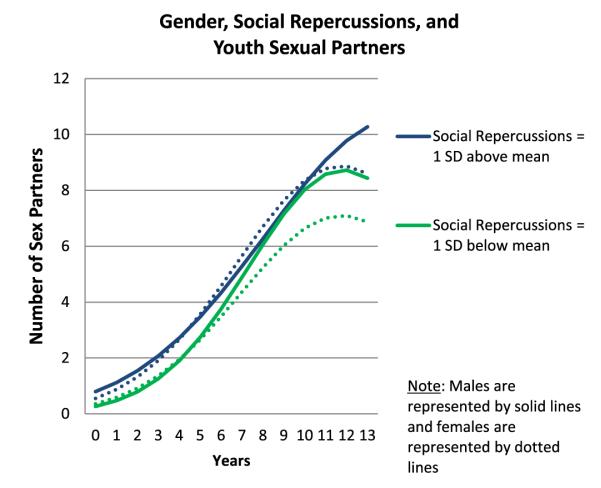Abstract
Purpose
An early age of sexual initiation and sexual activity with multiple partners are risk factors for an array of detrimental outcomes. Drawing on social norms theory, this study assessed the role of subjective and descriptive social norms from parents, peers, and schoolmates on trajectories of sexual partner accumulation from early adolescence through early adulthood.
Methods
Data were drawn from the in-home survey sample of Add Health, following 14,797 youth from adolescence through early adulthood. Social norms data were drawn from youth, parent, schoolmate, and school administrator reports. Multi-level growth models assess how parent, peer, and school social norms predicted initial levels and growth in sexual partner accumulation.
Results
Parent and peer approval of youth sexual behavior, as well as lower perceived negative repercussions of pregnancy, predicted greater initial levels and greater growth over time in the accumulation of sexual partners. Similarly, youth attending schools with a greater proportion of sexually experienced schoolmates reported higher initial levels of sexual partners. In contrast, greater parental warnings regarding negative consequences of sex predicted heightened sexual partner accumulation. Some moderation by youth gender and age emerged as well.
Conclusions
Results highlight the role of both subjective and descriptive social norms, suggesting the importance of understanding and seeking to influence the social beliefs and expectations of youth and their families.
Keywords: Sexual risk behaviors, Multiple partners, Adolescence, Social norms, Peers
An early age of sexual initiation and engagement in sexual activity with multiple partners are risk factors for an array of detrimental outcomes including unplanned pregnancies and sexually transmitted infections (STIs) [1], due both to increased risk exposure and to less planful and less risk-averse behavior of adolescents [2]. Hence, understanding the correlates and pathways of early and multi-partner sexual activity is essential for informing prevention efforts. Seeking to understand the correlates of early and risky sexual activity, research has identified the importance of social norms within individuals’ proximal contexts as a central force constraining and enabling adolescents’ behaviors. Sieverding and colleagues [3] delineate two types of social norms. Subjective norms tap into an individual’s perceptions of what behaviors others approve of, which influence an individual’s behaviors through pressures to conform to the wishes of important others [4,5]. Descriptive norms are defined as the normative behaviors of persons in the social milieu that indicate what actions are acceptable versus deviant or off-limits [6,7], and can be assessed by both the individual’s perception of normative behavior and the actual state of normative behavior as “individuals are at least marginally aware of the existing norms and tend to act in accordance with them” [8]. Social norm contexts during adolescence may be particularly influential, as at this developmental stage individuals are formulating and solidifying their value systems and identities [9]. If the behaviors and expectations of important others affect adolescents’ sexual mores, then we would expect associations with longer-term trajectories of sexual behaviors. Alternately, associations may be short-lived, as new social norm contexts (e.g., from college or romantic relationships) alter youths’ sexual mores and behaviors in early adulthood.
Among adolescents, social norms may be derived from both proximal (e.g., family and closest friends) and distal (e.g., broader peer and school contexts) sources. Evidence indicates that parents and peers are particularly important sources of social norms. Parental subjective norms are linked to adolescent sexual beliefs and behaviors including sexual debut [10], number of partners [11], and contraceptive use [12]. For example, maternal disapproval of sexual intercourse has been associated with later initiation of sexual intercourse [10] and lower partner accumulation among adolescents, particularly females [11]. This relationship declined as youth entered early adulthood, suggesting that maternal disapproval may slow initiation into risky sexual behaviors but that this protection is relatively short-lived [11]. There is some evidence that peer approval of sexual behaviors is linked to youth sexual partner accumulation during adolescence, with associations fading over time [11]. Prior research has not assessed whether subjective social norms during adolescence have long-term effects, nor examined the relative contributions of subjective norms from parents, peers, and broader social contexts, two central goals of this study.
Research on the role of descriptive norms has focused primarily on peers, with a growing body of literature highlighting the role of descriptive norms from peer groups in teens’ engagement in risky sexual behaviors. Peer behaviors have been linked to both sexual debut [13] and condom use [14,15] in short-term prospective designs. We seek to add to this literature by assessing the influence of descriptive norms from broader school contexts and by assessing whether adolescent descriptive norm contexts have long-term associations with sexual risk behaviors. Moreover, little research has carefully attended to the role of youth gender and age. For young adolescents, parental and peer approval and peer engagement in sexual activity may be less normative, and hence more influential than for older adolescents. Similarly, the more restrictive social norms concerning female (vs. male) sexual activity may enhance the effect of permissive social norms on females’ behaviors [16]. It is unclear if these differences would be short-lived, or extend in influence into adulthood.
Expanding upon extant research, this study contributes to the field by assessing (1) the relative contributions of subjective and descriptive norms derived from parents, peers, and schoolmates on youth sexual partner accumulation; (2) whether adolescent social norm contexts are associated with growth in partner accumulation into adulthood; and (3) whether the concurrent and prospective effects of social norms differ by youth age and gender. Overall, we seek to improve our understanding of adolescent risky sexual behaviors, when they emerge, and how they evolve from adolescence through early adulthood.
Method
Sampling and data collection
Data were drawn from the in-home survey sample of the National Longitudinal Study of Adolescent Health (Add Health), a longitudinal survey of a nationally representative school-based sample of adolescents in the United States. From the baseline school sample, a stratified sample of 7th through 12th graders was selected for the in-home surveys. This sample was interviewed over four waves in 1995, 1996, 2001/2, and 2007/8, with response rates of 79%, 88%, 77%, and 80% respectively. Youth averaged 15 years of age at Wave 1 and 29 years of age at Wave 4. Parent and school administrator report data were also collected at Wave 1. Our analytic sample included all youth participating in the in-home surveys with valid survey weights and school IDs, N = 14,797. Missing data in the analytic sample ranged from 0% (age and gender) to 33.35% (parental approval) and were imputed using a bootstrap-based Expectation Maximization Bayesian (EMB) algorithm [17] in R to create ten complete data sets.
Measures
Sexual partner accumulation. Information on cumulative sexual partners was measured through self-report at each wave using Audio Computer Assisted Self Interviewing.1 Sexual partner accumulation was coded as a count variable at each wave, capped at 50 and stable or increasing across waves. The cumulative number of partners was assessed to consider linear (and nonlinear) growth over time in sexual risk.2
Social norms
Information on subjective and descriptive social norms was derived through youth, parent, schoolmate, and school administrator reports and was coded such that higher scores indicated norms that were more accepting or promoting of sexual activity. Four measures assessed subjective norms. Parental Approval of sexual engagement assessed youth perceptions of mothers’ and fathers’ feelings about their having sex, using birth control, and having sex within a steady relationship (6 items; α = .89; 1 = Strongly Disapprove to 5 = Strongly Approve). If youth did not live with both parents, scores for only the resident parent were used. Limited Parental Warnings was derived from parent reports assessing communication concerning dangers of pregnancy, STIs, reputation, and morality, coded so that high scores indicated fewer parental warnings (4 items; α = .87; 1 = A Great Deal to 4 = Not At All). We argue that youth perceive and interpret these parental warnings, and thus they serve as a subjective norm. Limited Social Repercussions of pregnancy assessed youths’ views regarding how much becoming pregnant/getting someone pregnant would embarrass their family and themselves; higher scores indicated less embarrassment (2 items, r = .66; 1 = Strongly Agree to 5 = Strongly disagree). Peer Approval of sex was derived from youth reports on how much they would gain respect from friends and be seen as more attractive by the opposite gender if they had sex (r = .30; 1 = Strongly Disagree to 5 = Strongly Agree).
Two school-level descriptive norm variables were assessed. Schoolmate Sexual Experience was drawn from self-reports from all survey youth aggregated to the school level to delineate the percent of students in each school who had had sexual intercourse. Schoolmate Pregnancies reflect school administrator reports of the number of pregnant students in the prior year (coded as percent of female students).
Covariates
Characteristics of youth, families, and schools were included due to their associations with social norms and risk behaviors in prior literature. Youth characteristics included gender, age in years at Wave 1, race/ethnicity, and immigrant status. Youth’s marital status was assessed at each wave, and a dichotomous variable indicated whether they had any college education by Wave 4. Family covariates derived from Wave 1 youth and parent reports included indicators of the primary caregiver’s marital history, and whether the youth’s biological father and biological mother lived in the household. Parents reported their highest level of education and family income to needs (to account for family size). School-level covariates from administrator reports denoted whether the school was public (vs. private/religious), and included high school grades (vs. only grades 6, 7, and/or 8). Urbanicity and region also were assessed.
Analytic technique
Multilevel growth modeling assessed trajectories of sexual partner accumulation over time using a generalized linear model with an overdispersed Poisson sampling distribution and a log-link function to account for the count variable and non-normal distribution [18,19]. A three-level model was used, with repeated measures at level 1 nested within individuals at level 2 and within schools at level 3. Time was coded in years, centered at Wave 1 such that the model intercept represents each individual’s sexual partner accumulation by Wave 1. Initial unconditional models indicated nonlinear growth, therefore models assessed both linear and nonlinear growth per year.3 The first model evaluated main effects of social norms and individual, family, and school covariates, followed by two additional models assessing age and gender moderation. All analyses were conducted using the Wave 1 grand sample weight and adjusting for school clustering.
Results
Descriptive results
Table 1 presents descriptive statistics on the imputed, weighted sample. On average, youth reported just under one partner at Wave 1, rising to more than one partner at Wave 2, and to over 11 partners by Wave 4, when youth averaged 29 years old. Although 69% of youth reported 0 sexual partners at Wave 1, this dropped quickly, to 14% by Wave 3 and 4% by Wave 4, supporting the use of a Poisson model.
Table 1.
Sample descriptives (n = 14,797)
| Wave 1 |
Wave 2 |
Wave 3 |
Wave 4 |
|
|---|---|---|---|---|
| mean (SD) or % |
mean (SD) or % |
mean (SD) or % |
mean (SD) or % |
|
| Dependent variable | ||||
| Number of partners |
.91 (3.85) | 1.38 (4.80) | 5.93 (12.49) | 11.57 (18.06) |
| Subjective social norms |
||||
| Parental approval | 2.05 (1.34) | |||
| Limited parental warnings |
2.10 (1.26) | |||
| Limited social repercussions |
2.30 (2.43) | |||
| Peer approval | 2.41 (1.44) | |||
| Descriptive social norms |
||||
| Schoolmate % sex | .38 (.27) | |||
| Schoolmate % pregnant |
.02 (.44) | |||
| Youth covariates | ||||
| Male | 48.97 | |||
| Female | 51.03 | |||
| Age Wave 1 | 15.44 (2.52) | |||
| White | 67.34 | |||
| African-American | 14.49 | |||
| Hispanic | 10.30 | |||
| Asian | 2.76 | |||
| Multiracial and other |
5.11 | |||
| U.S.-born | 94.96 | |||
| Married | 0 | 1.85 | 18.78 | 43.06 |
| College | - | - | - | 67.61 |
| Father in household |
60.17 | |||
| Mother in household |
87.81 | |||
| Parent married | 69.05 | |||
| Parent previously married |
25.14 | |||
| Parent < 8th grade education |
5.76 | |||
| Parent < high school education |
11.85 | |||
| Parent high school education |
30.91 | |||
| Parent > high school education |
28.29 | |||
| Parent college/ graduate school |
23.19 | |||
| Family income- to-needs |
2.98 (4.31) | |||
| School covariates | ||||
| Public | 93.33 | |||
| Private | 6.67 | |||
| School includes high school grades |
65.65 | |||
| Urban area | 25.22 | |||
| Suburban area | 58.63 | |||
| Rural area | 16.15 | |||
| West region | 15.67 | |||
| Midwest region | 33.10 | |||
| Northeast region | 12.13 | |||
| South region | 22.95 |
Parent, peer, and school social norms predicting trajectories of partner accumulation
The first multilevel growth model, presented in Table 2, includes the full set of social norm variables and covariates as predictors of individuals’ starting level (intercept), linear (slope), and nonlinear (slope squared) growth. Results show that all three parent subjective social norms were significant predictors of youth partner accumulation. The event (incident) rate ratios, which are exponentiated coefficients, represent the amount of change in partner accumulation for a one unit change in the predictor. Results indicate that a one unit difference in youth perceptions of parental approval of their sexual activity predicted a 49% higher level of partner accumulation at Wave 1. Parental approval also predicted linear and nonlinear slopes. Because the model used a Poisson distribution, the change over time is logarithmic rather than linear. Graphing the results (Figure 1), shows that slope effects translated into growing divergence in partner accumulation over time. Youth who perceived greater parental approval of their sexual activity both started with higher partner accumulation by Wave 1, and grew more quickly over time than peers with lower parental approval. Indeed, youth with parental approval ratings one SD above the mean had a predicted level of over 13 sexual partners by the fourth wave (year 13), whereas youth with parental approval ratings one SD below the mean had a predicted level of over five sexual partners by the fourth wave, nearly a half a SD difference.
Table 2.
Summary of coefficients and standard errors for conditional three-level hierarchal linear regression model (N = 14,797)
| Intercept |
Slope |
Slope squared |
|||||||
|---|---|---|---|---|---|---|---|---|---|
| Coef | SE | ERR | Coef | SE | ERR | Coef | SE | ERR | |
| Intercept | −.79** | .04 | .45 | .48** | .01 | 1.62 | −.020** | .00 | .980 |
| Marrieda | −.19** | .02 | .83 | ||||||
| Social norms variables | |||||||||
| Parental approval | .40** | .04 | 1.49 | −.04** | .01 | .96 | .002** | .00 | 1.001 |
| Limited parental warnings | −.19** | .05 | .83 | .02* | .01 | 1.03 | −.001 | .00 | 1.002 |
| Limited social repercussions | .17** | .03 | 1.19 | −.03** | .01 | .97 | .002** | .00 | 1.002 |
| Peer approval | .23** | .04 | 1.26 | −.03** | .01 | .97 | .002* | .00 | 1.002 |
| Schoolmate % sex | .74* | .31 | 2.10 | −.06 | .08 | .94 | .001 | .00 | 1.001 |
| Schoolmate % pregnant | −.02 | .09 | .98 | −.01 | .03 | .99 | .001 | .00 | 1.001 |
| Individual covariates | |||||||||
| Male | .00 | .07 | 1.00 | −.01 | .02 | .99 | .002 | .00 | 1.002 |
| Age Wave 1 | .19** | .03 | 1.20 | −.04** | .01 | .96 | .002** | .00 | 1.002 |
| African-American | .25** | .09 | 1.28 | −.07** | .02 | .94 | .004** | .00 | 1.004 |
| Hispanic | .26 | .18 | 1.29 | −.06 | .05 | .94 | .003 | .00 | 1.003 |
| Asian | −.18 | .20 | .84 | −.07 | .05 | .93 | .003 | .00 | 1.005 |
| Multiracial and other | .38** | .15 | 1.47 | −.06 | .04 | .94 | .002 | .00 | 1.003 |
| U.S.-born | .53** | .17 | 1.71 | −.09 | .04 | .92 | .004 | .00 | 1.004 |
| Collegeb | .00 | .01 | 1.00 | .000 | .00 | 1.001 | |||
| Family covariates | |||||||||
| Father in household | −.28** | .06 | .76 | .02 | .02 | 1.02 | −.001 | .00 | .999 |
| Mother in household | −.18* | .09 | .84 | .00 | .02 | 1.00 | .000 | .00 | 1.000 |
| Parent married | −.06 | .14 | .95 | .03 | .04 | 1.03 | −.002 | .00 | .999 |
| Parent previously married | .06 | .14 | 1.06 | .00 | .04 | 1.00 | .000 | .00 | 1.000 |
| Parent < 8th grade education | −.09 | .17 | .91 | −.03 | .05 | .97 | .002 | .00 | 1.002 |
| Parent < high school education | −.10 | .10 | .90 | .00 | .03 | 1.00 | .001 | .00 | 1.001 |
| Parent > high school education | −.07 | .08 | .93 | .00 | .02 | 1.00 | −.000 | .00 | 1.001 |
| Parent college/graduate school | −.19* | .09 | .83 | .01 | .02 | 1.01 | −.000 | .00 | 1.000 |
| Family income-to-needs | .01 | .01 | 1.01 | .00 | .00 | 1.00 | .000 | .00 | 1.000 |
| School covariates | |||||||||
| Public | .24 | .16 | 1.27 | −.08* | .03 | .92 | .005 | .00 | 1.005 |
| School has high school grades | .12 | .13 | 1.13 | −.02 | .03 | .98 | .001 | .00 | 1.001 |
| Urban area | −.07 | .09 | .93 | .00 | .02 | 1.00 | .000 | .00 | 1.000 |
| Rural area | −.06 | .06 | .94 | .01 | .02 | 1.00 | −.001 | .00 | 1.000 |
| West region | −.03 | .12 | .97 | −.02 | .02 | .98 | .001 | .00 | 1.001 |
| Midwest region | .12 | .09 | 1.13 | −.03 | .02 | .97 | .002 | .00 | 1.001 |
| Northeast region | −.02 | .09 | .98 | −.01 | .02 | .99 | .000 | .00 | 1.000 |
Coef = Coefficient; SE = Standard Error; ERR = Event Rate Ratio.
p < .05.
p < .01.
Youth married status was included as a time-varying covariate in level 1 of the model, and hence is predicting partner accumulation at each wave.
College attcndancc was only included as a predictor of linear and nonlinear slope.
Figure 1.
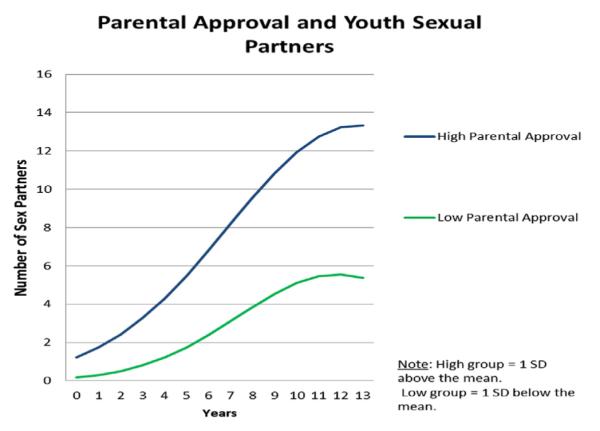
The relationship between parental approval and youth sexual partner accumulation over time.
Youth reports of limited perceived social repercussions of a pregnancy showed a similar pattern, with a one unit difference in limited social repercussions predicting 19% higher partner accumulation at Wave 1 and significant linear and nonlinear slopes, which translated into slightly increasing discrepancies over time in partner accumulation (figures for all significant results are included in the Appendix). Limited parental warnings about the negative repercussions of sex, on the other hand, showed a different pattern, with a one-unit difference in limited parental warnings predicting 17% fewer partners by Wave 1, with a positive slope. That is, youth whose parents provided more warnings had higher initial levels of partner accumulation, and increased more quickly over time than their peers.
The next set of social norm variables address peer and school norms. The subjective norm of greater peer approval of sexual behavior predicted higher starting levels and greater growth in partner accumulation. The descriptive norm of having a greater proportion of sexually experienced schoolmates also predicted higher initial levels of individual’s partner accumulation, but was not significantly associated with change in partner accumulation over time. The final descriptive social norm, assessing the schoolmate pregnancies per administrator reports, was not significantly associated with youth partner accumulation.
Age and gender interactions
Because Add Health covered ages 12 to 18 in Wave 1, it was important to consider whether youth age moderated associations between social norms and partner accumulation. The top panel of Table 3 presents interactions between Wave 1 age and the social norm variables. All covariates were included in the interaction models, though the table presents only main coefficients of interest. Two significant age interactions emerged. First, youth age interacted with parental approval of sex to predict the intercept and slope of youths’ partner accumulation. Figure 2 graphs the results, showing that older youth with greater parental approval started with the highest level of partner accumulation at Wave one, higher than age mates with lower parental approval and higher than younger peers with higher and lower approval, respectively. However, younger youth with high parental approval grew more quickly over time in partner accumulation, surpassing their older peers. In short, greater parental approval in early adolescence showed long-term associations with growth in sexual risk behaviors into adulthood. The second significant interaction, between youth age and schoolmate sexual activity, showed a similar pattern. That is, younger participants who attended schools where a larger percentage of students were sexually active started lower than their older peers in partner accumulation, but grew more quickly and surpassed their older peers (additional interaction figures can be found in an appendix to the online edition of this article).
Table 3.
Summary of coefficients and standard errors for three-level hierarchal linear regression models with age interactions and gender interactions (N = 14,797)
| Intercept |
Slope |
Slope squared |
|||||||
|---|---|---|---|---|---|---|---|---|---|
| Coef | SE | ERR | Coef | SE | ERR | Coef | SE | ERR | |
| Model 2: Age interactions | |||||||||
| Intercept | −.73** | .05 | .48 | .48** | .01 | 1.61 | −.020** | .00 | .980 |
| Main effect terms | |||||||||
| Age Wave 1 | .28** | .03 | 1.32 | −.06** | .01 | .95 | .003** | .00 | 1.003 |
| Parental approval | .42** | .04 | 1.52 | −.05** | .01 | .95 | .002** | .00 | 1.002 |
| Limited parental warnings | −.20** | .05 | .82 | .03* | .01 | 1.03 | −.002* | .00 | .999 |
| Limited social repercussions | .20** | .04 | 1.22 | −.03** | .01 | .96 | .002** | .00 | 1.002 |
| Peer approval | .27** | .05 | 1.30 | −.04** | .01 | .96 | .002* | .00 | 1.002 |
| Schoolmate % sex | .81* | .32 | 2.25 | −.11 | .08 | .90 | .004 | .00 | .997 |
| Schoolmate % pregnant | −.02 | .11 | .98 | .00 | .03 | 1.00 | .000 | .00 | 1.000 |
| Interaction terms | |||||||||
| Age* parental approval | −.06** | .02 | .94 | .01* | .01 | 1.01 | −.000 | .00 | .999 |
| Age* limited parental warnings | .03 | .02 | 1.03 | −.01 | .01 | .99 | .001 | .00 | 1.000 |
| Age* limited social repercussions | −.03 | .02 | .97 | .01 | .01 | 1.01 | −.001 | .00 | 1.000 |
| Age* peer approval | −.02 | .03 | .98 | .01 | .01 | 1.01 | −.000 | .00 | 1.000 |
| Age* schoolmate % sex | −.40** | .12 | .67 | .07* | .03 | 1.08 | −.003 | .00 | .997 |
| Age* school mate % pregnant | .02 | .06 | .99 | −.02 | .02 | .98 | .001 | .00 | 1.001 |
| Model 3: Gender interactions | |||||||||
| Intercept | −.75** | .05 | .45 | .48** | .01 | 1.62 | −.020** | .01 | .981 |
| Main effect terms | |||||||||
| Male | .03 | .08 | 1.04 | −.02 | .02 | .98 | .001* | .00 | 1.002 |
| Parental approval | .42** | .03 | 1.52 | −.05** | .01 | .95 | .000** | .00 | 1.002 |
| Limited parental warnings | −.18** | .04 | .84 | .02* | .01 | 1.02 | −.001 | .00 | .999 |
| Limited social repercussions | .16** | .03 | 1.17 | .02** | .01 | .97 | .001** | .00 | 1.001 |
| Peer approval | .23** | .04 | 1.26 | −.03** | .01 | .97 | .002* | .00 | 1.002 |
| Schoolmate % sex | .81** | .29 | 2.29 | −.08 | .08 | .92 | .002 | .00 | 1.002 |
| Schoolmate % pregnant | −.03 | .09 | .96 | −.01 | .02 | .99 | .001 | .00 | 1.001 |
| Interaction terms | |||||||||
| Male* parental approval | −.15* | .07 | .86 | .04* | .02 | 1.04 | −.002* | .00 | .998 |
| Male* limited parental warnings | −.11 | .07 | .90 | .02 | .02 | 1.02 | .001 | .00 | .999 |
| Male* limited social repercussions | .14* | .05 | 1.14 | .04** | .01 | .96 | .002** | .00 | 1.002 |
| Male* peer approval | .02 | .08 | 1.02 | −.00 | .02 | 1.00 | .000 | .00 | 1.000 |
| Male* schoolmate % sex | −.45 | .39 | .66 | .17 | .10 | 1.19 | −.010 | .01 | .990 |
| Male* schoolmate % pregnant | .10 | .18 | 1.10 | −.08 | .05 | .93 | .005 | .00 | 1.005 |
Note: All covariates included in Table 2 are also included in interactive models. Coef = Coefficient; SE = Standard Error; ERR = Event Rate Ratio.
p < 05.
p < .01.
Figure 2.
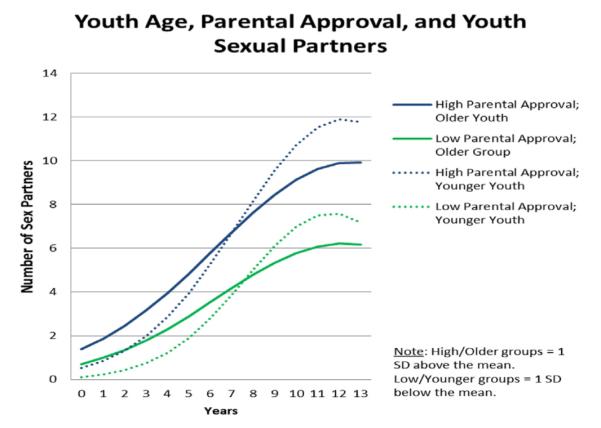
Interactions between youth age at Wave 1 and parental approval predicting partner accumulation over time.
The second set of interactions assessed whether social norms effects differed for males and females. Both parental approval and limited social repercussions interacted with youth gender. At Wave 1, parental approval was more strongly associated with females’ than males’ partner accumulation, but over time, parental approval was associated with more rapid increases in partner accumulation for males than females. In relation to limited social repercussions of pregnancy, however, this pattern differed. Greater perceived negative repercussions of a pregnancy predicted lower partner accumulation by Wave 1 more strongly for males, but over time the partner accumulation grew more for females with low perceived repercussions of pregnancy.
Discussion
Results from this study illustrate the important role that subjective and descriptive social norms from parents, peers, and schoolmates may play in predicting youths’ accumulation of sexual partners from early adolescence through early adulthood, an important risk factor for negative consequences such as STIs and unplanned pregnancies. Perhaps the strongest and most consistent pattern unearthed in this nationally representative sample was the role of youths’ perceptions of parent and peer approval of sexual activity. Youth who perceived that their parents and peers were more accepting of sexual activity, or that they would suffer minimal embarrassment from a potential pregnancy, had higher numbers of sexual partners than their peers at the initiation of the study. Importantly, these differences grew over time as youth traversed adolescence and transitioned into early adulthood, with particularly steep growth rates among youth who perceived greater parental approval of sexual activity during their early adolescence. Results highlight that youth perceptions of expectations and beliefs from their most proximal contexts, parents and peers, operate independently and have long-term prospective associations with youth partner accumulation, adding to prior literature, which has predominantly assessed subjective social norms from one source at a time and has not followed youth through their twenties. These results could indicate the causal influence of subjective social norms on individual behaviors, yet we cannot rule out alternate explanations, such as that youth seek to diminish cognitive dissonance, reporting their perceptions of important others’ beliefs to match their existing behaviors. Yet this explanation cannot explain the prospective links with growth in partner accumulation over time.
A second pattern of results concerned the role of descriptive social norms, with greater exposure to sexually active schoolmates predicting higher initial levels of partner accumulation. For youth who were exposed to more sexually experienced schoolmates early in their adolescence, exposure also predicted increased growth in partner accumulation through early adulthood. Together with above discussed results, these patterns suggest that social norms approving of or modeling sexual activity during early adolescence may be particularly influential in setting youth on a trajectory of heightened risk behaviors that last through early adulthood (although we cannot rule out the possibility that age interactions were due to cohort effects rather than age differences). In contrast, the proportion of pregnant schoolmates was not associated with youth partner accumulation. This null result may be due to biased reporting, with administrators not having full knowledge of all pregnancies, or to counteracting forces, with pregnancies signaling both the acceptability and negative consequences of sex.
Contrary to expectations, greater parental warnings regarding potential negative consequences of sexual activity predicted higher rather than lower partner accumulation. It may be that parental intervention is simply backfiring—that is, youth who are bombarded with parental warnings regarding the consequences of sex resist or react against such warnings. Alternately, child evocative effects may be at play, supporting previous research reporting that parents may respond to their adolescents’ sexual activity by increasing their parental monitoring [20]. It may be that these warnings are too little too late; results found that youth who received more negative warnings from their parents not only reported greater sexual partners at study entry than their peers, but also increased their partner accumulation more steeply into adulthood. More research is needed regarding how youth interpret warnings from parents and others to identify how such information can be relayed in an effective and influential manner.
Finally, we note the lack of consistent gender differences in the roles of social norm contexts. Among our six social norms, only two were moderated by youth gender, with contrasting patterns showing a stronger initial role of parental approval for females and of social repercussions for males, with both differences diminishing over time, suggesting that social influences are relatively similar for modern male and female youth.
In closing, it is important to note limitations of the current research. First, data were correlational, and could not adjust for all potential sources of influence on youth partner accumulation. Second, we assessed only one aspect of sexual risk behaviors; other risky sexual behaviors may show different relations with social norms contexts. Third, our social norms measures assessed youth, parent, schoolmate, and school administrator reports, with all but the last showing significant associations with youth partner accumulation. For youth and parent reported subjective norms, however, we cannot rule out the possibility that results reflect youth altering their perceptions and parents altering their messages to match existing youth behaviors. Another limitation was the availability of social norms information from only one wave. We urge future research tracking changing social norm contexts and assessing the relative role of norms during adolescence versus later periods. Longitudinal social norms data also would allow direct modeling of both selection into and consequences of particular social norms contexts. Finally, it is important to acknowledge that data collection began in 1994, and both social norms and youth sexual behaviors may have shifted in the intervening years. Indeed, recent research finds greater proportions of adolescents reporting multiple casual sex partners and greater proportions of virgins than previously, suggesting that youth sexual behaviors continue to evolve [21,22], although evidence has not suggested that processes affecting such behaviors have shifted. In better understanding current trajectories of youth sexual behaviors, our results suggest the importance of delineating and seeking to influence the social beliefs and expectations of youth and their families.
IMPLICATIONS AND CONTRIBUTION.
This study found that subjective and descriptive social norms from parents, peers, and schoolmates predicted heightened sexual partner accumulation. Results suggest the importance of understanding and seeking to influence the social beliefs and expectations of youth and their families in efforts to decrease sexual risk behaviors.
Acknowledgments
This research was funded with generous support from the W. T. Grant Foundation (grant 10909). This research uses data from Add Health, a program project designed by J. Richard Udry, Peter S. Bearman, and Kathleen Mullan Harris, and funded by a grant P01-HD31921 from the National Institute of Child Health and Human Development, with cooperative funding from 17 other agencies. Special acknowledgment is due Ronald R. Rindfuss and Barbara Entwisle for assistance in the original design. Persons interested in obtaining data files from Add Health should contact Add Health, Carolina Population Center, 123 W. Franklin Street, Chapel, Hill, NC 27516-2524 (addhealth@unc.edu).
Appendix.
Figure 3.
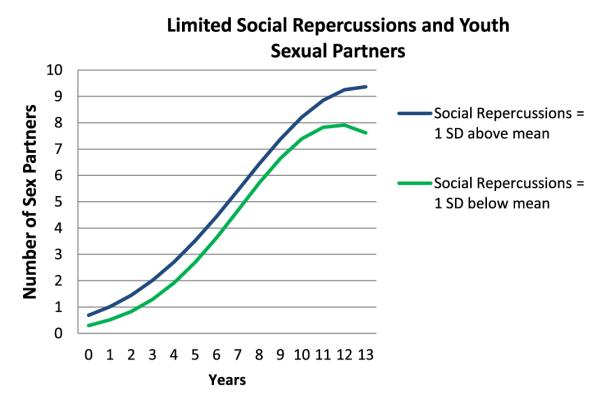
The relationship between social repercussions and youth sexual partner accumulation over time.
Figure 4.
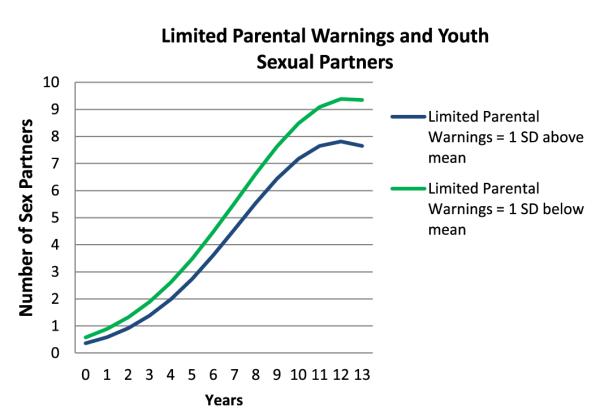
The relationship between limited parental warnings and youth sexual partner accumulation over time.
Figure 5.

The relationship between peer approval and youth sexual partner accumulation over time.
Figure 6.
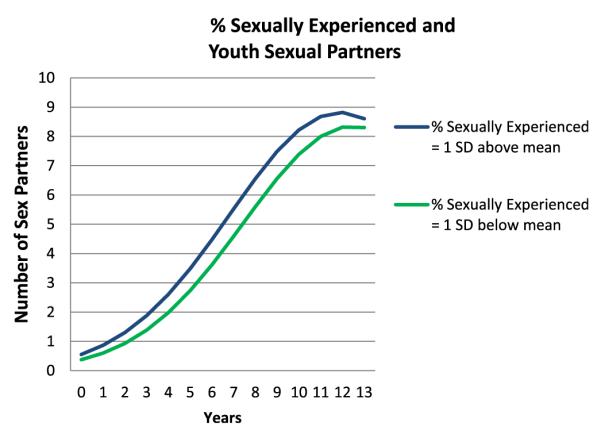
The relationship between schoolmate sexual experience and youth sexual partner accumulation over time.
Figure 7.
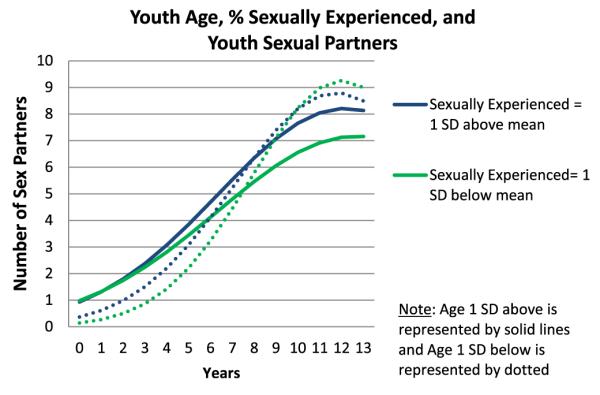
Interactions between age at Wave 1 and schoolmate sexual experience predicting partner accumulation over time.
Figure 8.
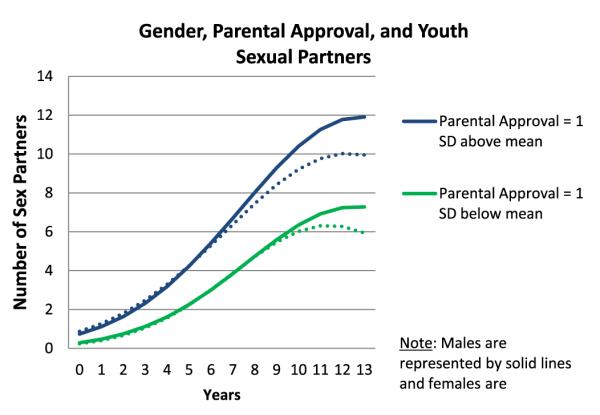
Interactions between gender and parental approval predicting partner accumulation over time.
Figure 9.
Interactions between gender and social repercussions predicting partner accumulation over time.
Footnotes
At the first two waves, youth reported on whether they had engaged in sexual intercourse with their three most recent romantic relationship partners and the number of sexual partners outside of these relationships; at the later two waves, youth reported the total number of partners with whom they had engaged in intercourse; sexual partners were not limited to opposite sex partners.
Our measure of sexual risk behaviors did not include other constructs such as use of effective birth control or frequency of sex both because these variables were not measured consistently and explicitly across all waves of Add Health, and also because birth control use and sex frequency in early adulthood, when many youth are in committed or married relationships, cannot necessarily be construed as “risky.”
Models were conducted using HLM. The equations for the three levels were of the format(1) Log(sexual partner accumulation) = P0 + P1*(Wave) + P2*(Wave2) + P3*(married); (2) P0 = B00 + B01*(parent/peer social norms) + B02*(individual covariates) + R0. P1 = B10 + B11*(parent/peer social norms) + B12*(individual covariates). P2 = B20 + B21*(parent/peer social norms) + B22*(individual covariates). P3 = B30; (3) B00 = G000 + G001(school social norms) + G002(school covariates)+ U00. B10 = G100 + G101(school social norms) + G102(school covariates). B20 = G200 + G201(school social norms) + G202(school covariates). B30 = G300.
References
- [1].O’Donnel LO, Stueve A, Wilson-Simmons R, et al. Heterosexual risk behaviors among urban young adolescents. J Early Adolesc. 2006;26:87–109. [Google Scholar]
- [2].Steinberg L. A social neuroscience perspective on adolescent risk-taking. Dev Rev. 2008;28:78–106. doi: 10.1016/j.dr.2007.08.002. [DOI] [PMC free article] [PubMed] [Google Scholar]
- [3].Sieverding M, Matterne U, Ciccarello L. What role do social norms play in the context of men’s cancer screening intention and behavior? Application of an extended theory of planned behavior. Health Psychol. 2010;29:72–81. doi: 10.1037/a0016941. [DOI] [PubMed] [Google Scholar]
- [4].Ajzen I, Fishbein M. Understanding attitudes and predicting social behavior. Prentice Hall; Englewood Cliffs, NJ: 1980. [Google Scholar]
- [5].Fishbein M, Ajzen I. Belief, attitude, intention and behaviour. Addison-Wesley; Reading, MA: 1975. [Google Scholar]
- [6].Cialdini RB. Influence: Science and practice. 3rd ed Harper Collins; New York: 1993. [Google Scholar]
- [7].Cialdini RB, Trost MR. Social influence: Social norms, conformity, and compliance. In: Gilbert D, Fiske S, Lindzy G, editors. The handbook of social psychology. Vol. 2. McGraw-Hill, Inc; Boston, MA: 1999. pp. 151–92. [Google Scholar]
- [8].Cialdini RB, Reno RR, Kallgren CA. A focus theory of normative conduct: Recycling the concept of norms to reduce littering in public places. J Pers Soc Psychol. 1990;58:1015–26. [Google Scholar]
- [9].Smetana J, Villalobos M. Social cognitive development in adolescence. In: Lerner R, Steinberg L, editors. Handbook of adolescent psychology. 3rd edition Wiley; New York: 2009. pp. 187–228. [Google Scholar]
- [10].Sieving RE, McNeely CS, Blum RW. Maternal expectations, mother-child connectedness, and adolescent sexual debut. Arch Pediatr Adolesc Med. 2000;154:809–16. doi: 10.1001/archpedi.154.8.809. [DOI] [PubMed] [Google Scholar]
- [11].Kan M, Cheng Y, Landale N, McHale SM. Longitudinal predictors of change in number of sexual partners across adolescence and early adulthood. J Adolesc. 2010;46:25–31. doi: 10.1016/j.jadohealth.2009.05.002. [DOI] [PMC free article] [PubMed] [Google Scholar]
- [12].Longmore MA, Manning WD, Giordano PC, Rudolph JL. Contraceptive self-efficacy: Does it influence adolescents’ contraceptive use? J Health Soc Behav. 2003;44:45–60. [PubMed] [Google Scholar]
- [13].Sieving RE, Eisenberg ME, Pettingell S, Skay C. Friends’ influence on adolescents’ first sexual intercourse. Perspect Sex Reprod Health. 2006;38:13–9. doi: 10.1363/psrh.38.013.06. [DOI] [PubMed] [Google Scholar]
- [14].Huebner DM, Neilands TB, Rebchook GM, Kregeles SM. Sorting through chickens and eggs: A longitudinal examination of the associations between attitudes, norms, and sexual risk behavior. Health Psychol. 2011;30:110–8. doi: 10.1037/a0021973. [DOI] [PMC free article] [PubMed] [Google Scholar]
- [15].Peterson JL, Bakeman R. Impact of beliefs about HIV treatment and peer condom norms on risky sexual behavior among gay and bisexual men. J Community Psychol. 2006;34:37–46. [Google Scholar]
- [16].Mahalik JR, Morray E, Coonerty-Femiano A, et al. Development of the Conformity to Feminine Norms Inventory. Sex Roles. 2005;52:317–35. [Google Scholar]
- [17].Honaker J, King G. What to do about missing values in time-series cross-section data. Am J Pol Sci. 2010;54:561–81. [Google Scholar]
- [18].Raudenbush SW, Byrk AS. Hierachichal linear models: Applications and data analysis methods. 2nd ed Sage; Newbury Park, CA: 2002. [Google Scholar]
- [19].Singer JD, Willett JB. Applied longitudinal data analysis: Modeling change and event occurrence. Oxford University Press; New York: 2003. [Google Scholar]
- [20].Coley RL, Votruba-Drzal E, Schindler H. Fathers’ and mothers’ parenting predicting and responding to adolescent sexual risk behaviors. Child Dev. 2009;80:808–27. doi: 10.1111/j.1467-8624.2009.01299.x. [DOI] [PubMed] [Google Scholar]
- [21].Chandra A, Mosher WD, Copen C, Sionean C. National health statistics reports. National Center for Health Statistics; Hyattsville, MD: 2011. Sexual behavior, sexual attraction, and sexual identity in the United States: Data from the 2006–2008 National Survey of Family Growth; p. 36. [PubMed] [Google Scholar]
- [22].Uecker JE, Regnerus MD. Bare market: Campus sex ratios, romantic relationships and sexual behavior. Sociol Q. 2010;51:408–35. doi: 10.1111/j.1533-8525.2010.01177.x. [DOI] [PMC free article] [PubMed] [Google Scholar]



